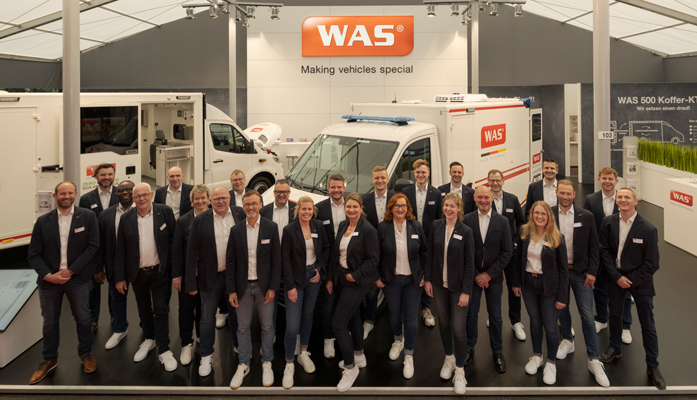

At RETTmobil, WAS will be demonstrating how forward-looking vehicle concepts are already proving their worth in the rescue service with a box ambulance, an E-ambulance, an E-first response vehicle and a new innovative ambulance table.
When developing new vehicle concepts, Wietmarscher Ambulanz- und Sonderfahrzeug GmbH (WAS) has always relied on close coordination with the regional rescue services. In this way, the practical experience of the users flows directly into new developments and improvements of the company. At RETTmobil, there are four innovations in particular that take this strategy into account.
Room for progress: the WAS 500 box patient transport ambulance
The trend towards lightweight box bodies in emergency rescue is also gaining ground in ambulance transport. Inspired by successful ambulance concepts, more and more national and international customers of the ambulance and special vehicle manufacturer WAS are opting for vehicle concepts with lightweight box bodies.
The company is responding to this demand with a new edition of the WAS 500 box patient transport ambulance, optionally based on a MAN TGE or VW Crafter. "More space in the patient compartment, lower fuel consumption and, above all, less weight - these factors are particularly important to our customers," says Andreas Plöger, Managing Director of WAS, summarising the experience gained in practice. The weight reserves are urgently needed, because with advancing medical-technical development, the demands on electro-hydraulic stretcher systems, among other things, are increasing. As a result, the technical and qualitative specifications increase the weight and dimensions of motorised stretcher systems from various suppliers. Here, the lightweight box body has the decisive advantage that the permissible total weight of 3.5 t usually required is not exceeded. In addition, more space is guaranteed in the patient compartment.
The new normal: the WAS 500 E-ambulance
E-mobility has arrived in the ambulance sector, and all the indications are that this forward-looking technology will continue to gain ground. Numerous cities in Germany and Europe are taking extensive measures to achieve their climate targets. This is being achieved in no small part by reducing the number of diesel-powered vehicles in inner-city traffic. E-mobility is no longer an exception: last year, the ambulance and special vehicle manufacturer WAS sent a prototype of its E-ambulance on a practical tour through Germany and Europe, and now more and more series models are being handed over to rescue services in Germany. Most recently, Europe's first fully electric ambulance in the 5.5 t class was handed over to the Hannover Fire Brigade's Fire and Rescue Station 1 for regular operation.
"As the feedback from the ambulance service managers makes clear, there are various reasons that make an increased inner-city use of WAS E-ambulances desirable. In the first place, as expected, is climate protection, but the good driving characteristics, the permissible total weight of 5.5 t as well as the lightweight box body also make a difference for inner-city use," as Andreas Plöger knows from discussions with users.
Proven vehicle concept, new basis: The WAS 100-E NEF
What has already proven to be successful for fully equipped box ambulances, WAS has also made ready for series production in the field of emergency medical services: the WAS 100-E NEF is an first response vehicle based on a Mercedes-Benz eVito, and thus the next fully electric vehicle concept from the manufacturer. In this case, too, thorough testing and inspection was carried out in advance. The German Red Cross in Frankfurt am Main had the opportunity to test the first vehicle in the region under the real conditions of the rescue service. During the test period, the electrically powered first responder was tested in 67 missions, covering approximately 1,209 km. The result: the Mercedes-Benz Vito, as a popular and proven basic vehicle, is also a winner with electric drive. On the basis of the test phase, three out of four respondents could already imagine using an all-electric NEF permanently in the Frankfurt ambulance service.
Beyond the ecological and economic advantages, the vehicle concept WAS 100-E NEF impressed users with its inner values. For example, the focus during the expansion was on the safety of the crew, without losing the weight reserve for the payload. Overall, the WAS 100-E NEF offers an above-average payload of 610 kg. This means that with a standard crew weight of 3 x 75 kg, there is an impressive remaining capacity of 385 kg.
Better from experience: The new WAS Hydro Universal Ambulance Table
Just like all the other components of the vehicles, the ambulance table is also constantly examined at WAS for improvement potential, and further developments are made accordingly. User wishes and suggestions were incorporated very early on in the development of today's standards, such as the head-up/head-down position, the side shift or even the switching between swing mode and fixation.
It is only comparatively recently that ergonomic and back-friendly work has become more and more important in the rescue service. WAS has taken this development as an opportunity to fundamentally revise its ambulance table. Tried and tested features, such as the electrohydraulics, have been optimised and retained, while other features have been rethought or added. As a result, the new ambulance table, WAS Hydro Universal, combines the advantages of the hydraulic table with those of the new electro-hydraulic stretcher and loading systems. At 500 kg, the new table has a load capacity of approx. 150 kg and is even easier to maintain thanks to the revised design.
Impressions RETTmobil 2023 in Fulda
Contact:
Wietmarscher Ambulanz- und Sonderfahrzeug GmbH
Simone Bergmann
Head of Marketing & Communication
Darwinstr. 11
D-48488 Emsbüren
s.bergmann@was-vehicles.com
Telephone: +49 5903 93201-170






